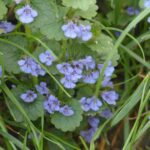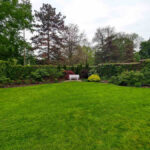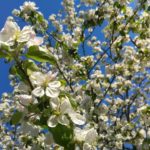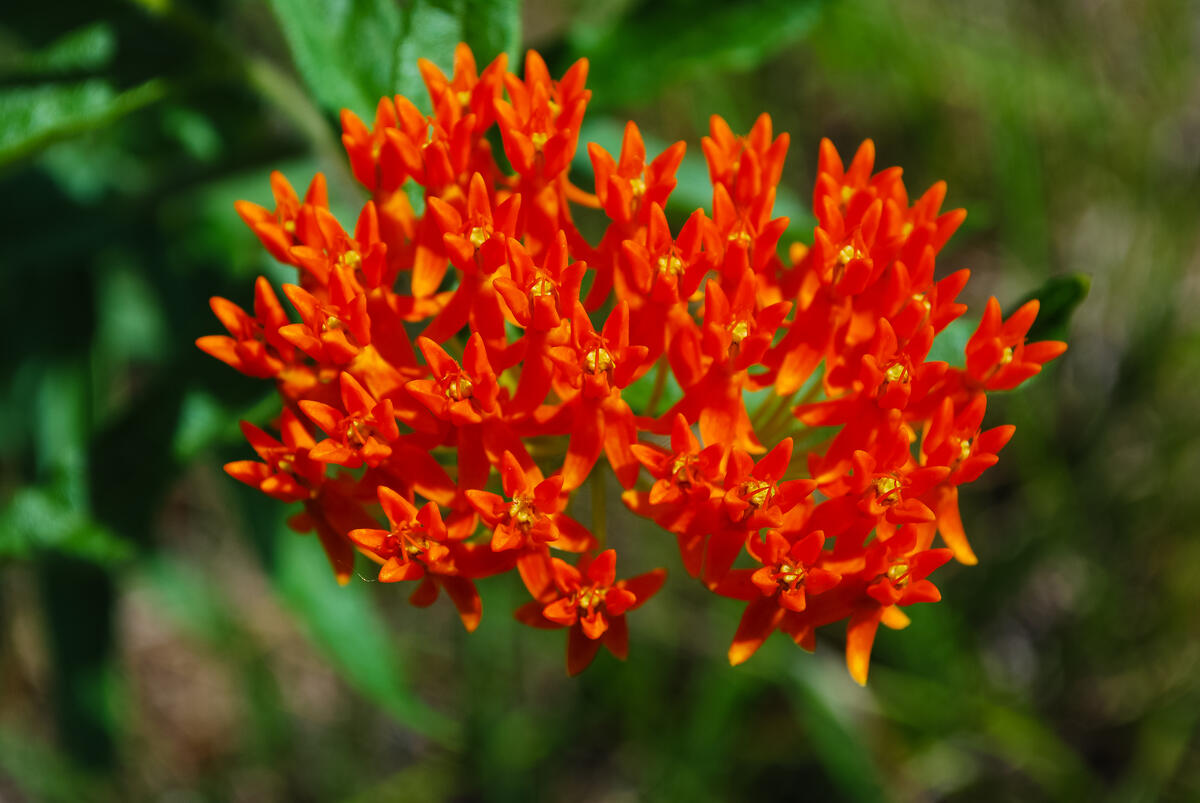
Pennsylvania is home to a diverse range of native plants that have adapted to the state’s unique climate and soil conditions. These plants have been growing and thriving in the region for thousands of years, making them well-suited to the local environment. In this article, we bring you 22 Pennsylvania native plants that would make a great addition to your garden.
By incorporating Pennsylvania native plants into your gardens, you’ll support your local ecosystem, promote biodiversity, and likely save some money in the process.
Pennsylvania Native Trees: Deciduous
Red Maple (Acer rubrum)
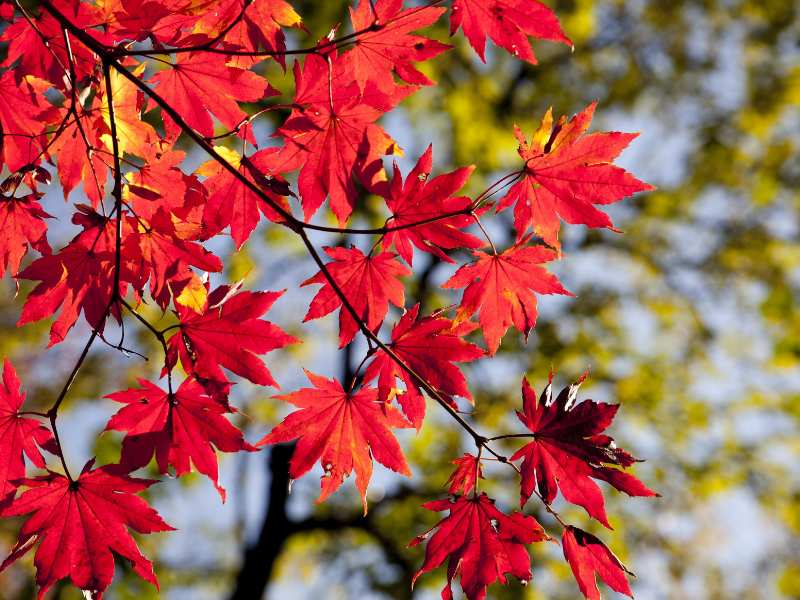
Pennsylvania is home to the beautiful red maple tree, which is favored for its fast growth rate and stunning fall foliage. Present throughout the state, this native tree is also widespread in the Pike County woods. The red maple boasts wide, three-lobed leaves with pointed tips that turn into a spectacular show of brilliant red or red/gold in the autumn.
In the spring, the leaves emerge with a red tint before transitioning to green for the summer, making them a sight to behold all year round. Due to its height, the red maple is an excellent option if you are looking for a fast-growing shade tree for your yard.
- Plant type: Tree
- USDA Hardiness Zone: 3-9
- Sun: Full sun, partial shade
- Soil: Chalk, clay, loam, sand
- Foliage: Deciduous
- Bloom time: March – April
- Water needs: Average
- Mature height: 40 to 70 feet
- Potential hazards: Toxic to horses
- Maintenance: They are susceptible to anthracnose, powdery mildew, fungal leaf spots like tar spot, and Verticillium wilt. Monitor the health of red maple trees to protect them from these diseases.
Eastern Redbud (Cercis canadensis)
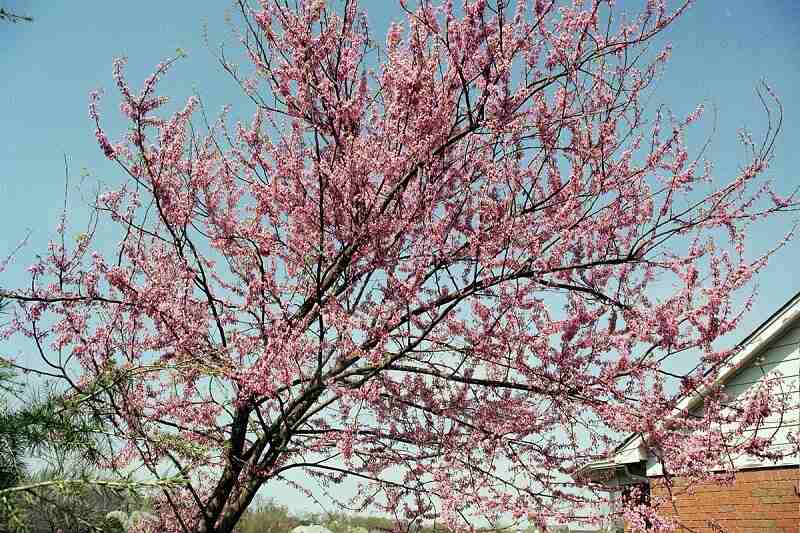
Eastern redbud is one of my favorite trees! Its unique, exquisite purple flowers grow directly on its branches and trunk, embellishing southern Pennsylvania. Perfect for smaller spaces, the eastern redbud is one of the best drought-tolerant trees you could wish for.
The Eastern redbud grows 20-30 feet tall and 25-35 feet wide, has a flat-topped to rounded growth habit, and has large heart-shaped leaves. It likes to make its appearance in early spring.
- Plant type: Tree
- USDA Hardiness Zone: 4 to 9
- Sun: Full sun or partial shade
- Soil: Any moist, well-draining, nutrient-rich soil
- Foliage: Deciduous
- Bloom time: Early spring, starting in early-to-mid April.
- Water needs: Keep the soil moist to a depth of 2 to 3 inches; the watering schedule depends on your soil type, but you should water about once per week.
- Mature height: 20 to 30 feet high, 25 to 35 feet wide
- Potential hazards: Contains saponin, a toxin that is generally not absorbed and passes through the body without issue
- Maintenance: Low maintenance. Since this tree is not meant to be transplanted, it should be planted when young and left undisturbed. It needs little pruning.
Flowering Dogwood (Cornus florida)
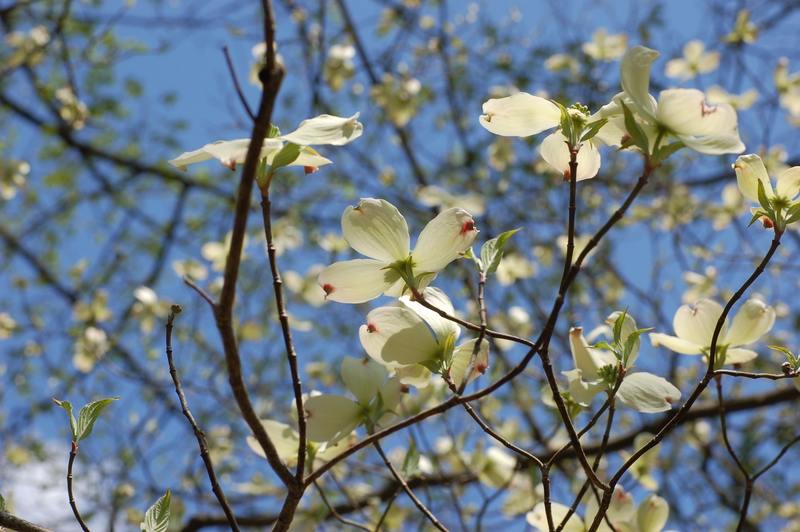
Photo Credit: Ram-Man / Wikimedia Commons / CC BY-SA 2.5
This stunning native tree is found throughout the state. Flowering dogwood boasts a short trunk with nearly horizontal branches, white and pink petals (bracts), red fruit, and striking scarlet autumn foliage. As a landscape designer, I have used it in smaller areas next to patios and at the edge of woodlands — it’s a delightful pop of color when it flowers.
- Plant type: Tree
- USDA Hardiness Zone: 5 to 9
- Sun: Grows best in partial shade but can tolerate full sun
- Soil: Organically rich, moist, acidic soil
- Foliage: Deciduous
- Bloom time: Flowers in early May
- Water needs: Medium
- Mature height: 15 to 30 feet, sometimes reaching up to 40 feet
- Potential hazards: The berries can cause gastrointestinal distress if consumed in excess.
- Maintenance: Low
Sugar Maple (Acer saccharum)
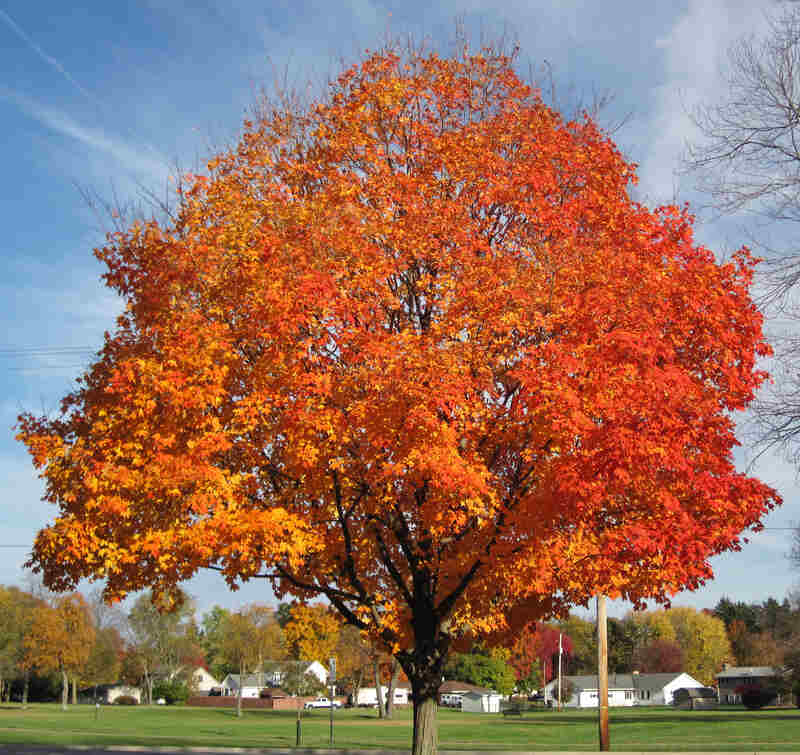
Maple syrup, anyone? This deciduous native species is found across Pennsylvania and is highly valued in the state for its sap, which is used to make maple syrup.
In addition to its practical uses, the sugar maple is also prized for its stunning fall foliage, which ranges from vibrant yellow to deep red and orange. The tree’s fruit takes the form of a distinctive two-winged samara.
- Plant type: Tree
- USDA Hardiness Zone: 4 to 8
- Sun: Full sun but can tolerate shade
- Soil: Grows best in deep, well-drained soils but tolerates various other soils. Does not like wet feet on swampy sites.
- Foliage: Deciduous
- Bloom time: April to May
- Water needs: As the tree becomes established, water 1 – 2 times weekly. Once established, expect to water 5 gallons or more per week.
- Mature height: 75 feet tall, 50 feet wide
- Potential hazards: Toxic to horses, non-toxic to people and pets
- Maintenance: Leaf spot diseases can cause the leaves to become disfigured and fall off early, while cankers can cause limb dieback and even kill the tree if they spread to the stem. These diseases are more likely to occur after severe winters or extended periods of drought.
White Oak (Quercus alba)
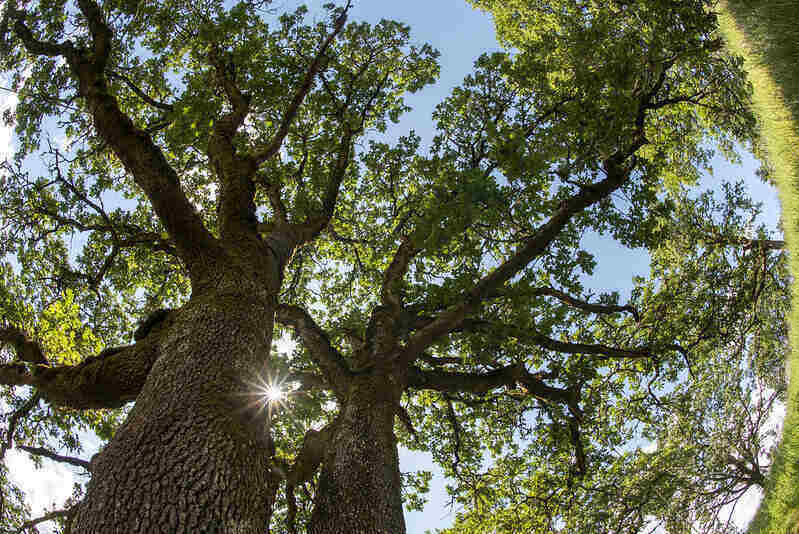
Present across Pennsylvania, the white oak tree is a majestic sight, reaching heights of 80 to 100 feet with a spread to match. Its bark is a light gray and appears scaly due to shallow furrows. The leaves of the white oak are smooth and light green, with a lighter underside, and come autumn, they turn a vibrant shade of red.
- Plant type: Tree
- USDA Hardiness Zone: 3 to 9
- Sun: Full sun or partial sun
- Soil: Moist, well-drained clay, loam, and sandy soils
- Foliage: Deciduous
- Bloom time: Blooms in May
- Water needs: Low
- Mature height: 80 – 100 feet high, 50 – 90 feet wide
- Potential hazards: Toxic to horses
- Maintenance: Low, but be aware of oak wilt in Pennsylvania. You’ll start to notice a dead branch or two a year. It’s a slow-moving oak tree disease and can take years for infected white oak group trees to die.
Pennsylvania Native Trees: Evergreen
Eastern White Pine (Pinus strobus)
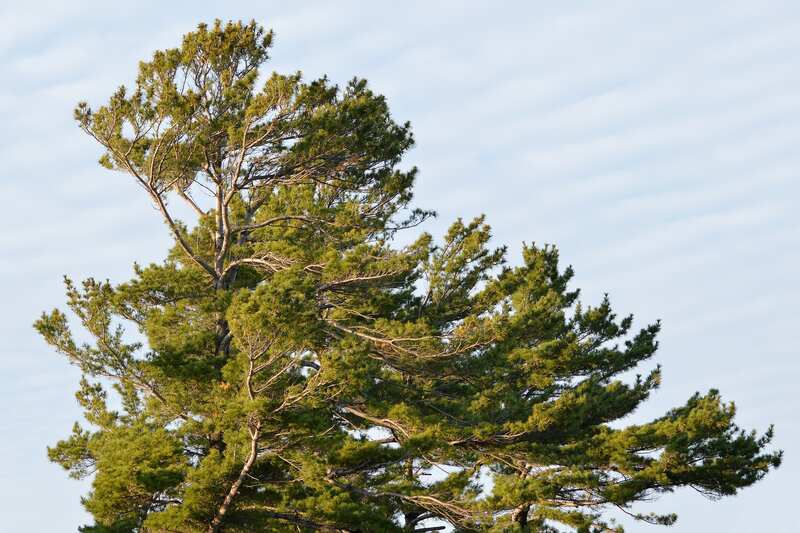
This beloved native evergreen is known for its distinctive pyramidal shape and soft, blue-green needles, which grow in groups of five and are 5 inches long. The tree also produces elongated brown cones 3-8 inches long. When planted in staggered rows, the eastern white pine is often used as a natural fence alternative.
- Plant type: Conifer, tree
- USDA Hardiness Zone: 3 to 9
- Sun: Full sun
- Soil: Loam, sand
- Foliage: Evergreen
- Bloom time: April
- Water needs: Low to average
- Mature height: 100 – 150 feet high, diameter is 40 inches
- Potential hazards: The resin might irritate the skin
- Maintenance: Low, but watch for white pine weevil damage. This weevil kills the terminal leader of eastern white pine.
Pennsylvania Native Shrubs: Deciduous
Spicebush (Lindera benzoin)
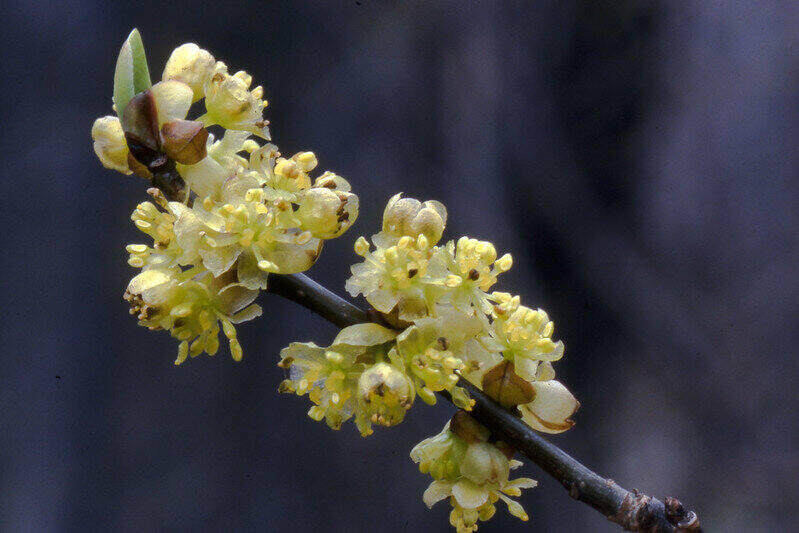
This deciduous shrub grows about 8 to 15 feet high and 6 to 15 feet wide. In early spring, beautiful small clusters of yellow flowers appear. The shrub produces a bright red drupe in the fall with a peppery taste and scent. The spicebush is a dioecious plant that requires a male pollinator plant to reproduce and makes a perfect native plant for your butterfly garden.
- Plant type: Shrub
- USDA Hardiness zones: 5a – 9a
- Sun: Partial shade
- Soil: Sandy, loamy, limestone-based
- Foliage: Deciduous
- Bloom Time: Flowers bloom from April to May, and the leaves typically appear in May, or approximately a month after the flowers.
- Water needs: Medium
- Mature height: 8-15 feet high, 6-15 feet wide
- Potential Hazards: None
- Maintenance: It is susceptible to laurel wilt.
Winterberry (Ilex verticillata)
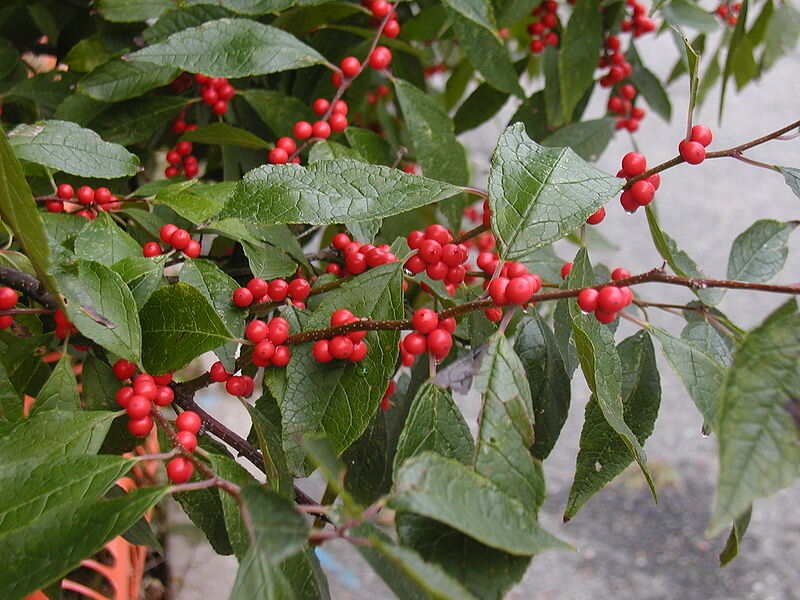
There is nothing more beautiful than seeing those fat red berries of the Winterberry shrub against a snowy backdrop of a Pennsylvania winter. The berries persist throughout the winter while most other plant material is dormant. Winterberry is a slow-growing shrub with a rounded, upright growth habit and can grow to 15 feet high in the right conditions.
- Plant type: Shrub
- USDA Hardiness zones: 3-9
- Sun: Full sun to partial shade
- Soil: Clay, loam, sand, moist, acidic
- Foliage: Deciduous
- Bloom Time: Mid-May to June; fruits appear in October and persist through the winter
- Water needs: Medium to high
- Mature height: 3-15 feet high, 3-12 feet wide
- Potential hazard: Might be toxic if ingested
- Maintenance: Low
Pennsylvania Native Shrubs: Evergreen
Inkberry (Ilex glabra)
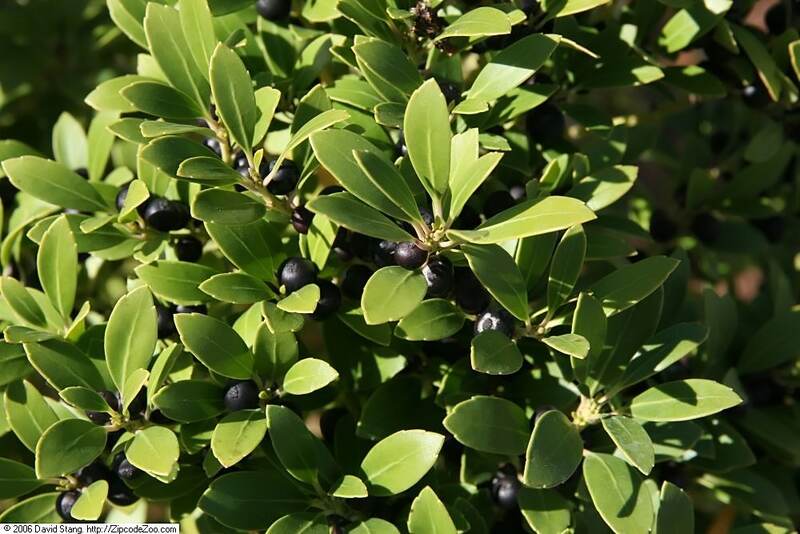
Inkberry is an extremely versatile evergreen shrub with a round habit of growth, small dark-green oval leaves, and black berries from mid-fall to late winter. It tends to be slightly leggy from about 1 foot above the ground. It can be used in a mass planting in your garden as a hedge or as a house foundation planting.
- Plant type: Evergreen shrub
- USDA Hardiness Zone: 4a-11b
- Sun: Full sun to partial shade
- Soil: Prefers moist to wet soil and must have rich, acidic soils; alkaline soils will cause chlorosis (yellowing of foliage)
- Foliage: Evergreen
- Bloom time: Flowers arrive in March-June. Berries appear in September-October, and the berries persist into the following spring.
- Water needs: Average
- Mature height: 5-10 feet high, 5-8 feet wide
- Potential hazards: Ingestion of berries is likely to cause minor gastric issues.
- Maintenance: Prune in late winter after the risk of harsh cold weather has subsided. Provide a thick mulch layer around its root zone for added protection if your Inkberry is exposed to colder temperatures or microclimates.
Pennsylvania Native Flowers
Sky Blue Aster (Symphyotrichum oolentangiense)
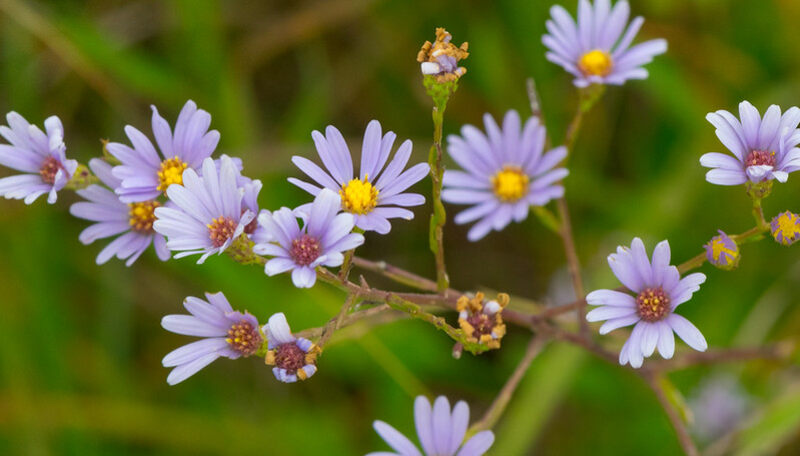
The aster, starwort, or frost flower is a perennial flower belonging to the daisy family. The sky blue aster is one of over 600 aster species and boasts a beautiful bluish-purple hue.
The aster may look like a single flower, but it’s actually a cluster of many small tubular flowers. Each tiny flower has its own reproductive organs, making the aster a unique and fascinating plant.
- Plant type: Flower
- USDA Hardiness zones: 3a – 8b
- Sun: Full sun, partial shade
- Soil: Sandy, loamy
- Foliage: Perennial
- Bloom time: Early September to late October
- Water needs: Medium
- Mature height: 2 – 3 feet high
- Potential hazards: None
- Maintenance: Divide every 2 to 3 years in the spring
Black-Eyed Susan (Rudbeckia hirta)
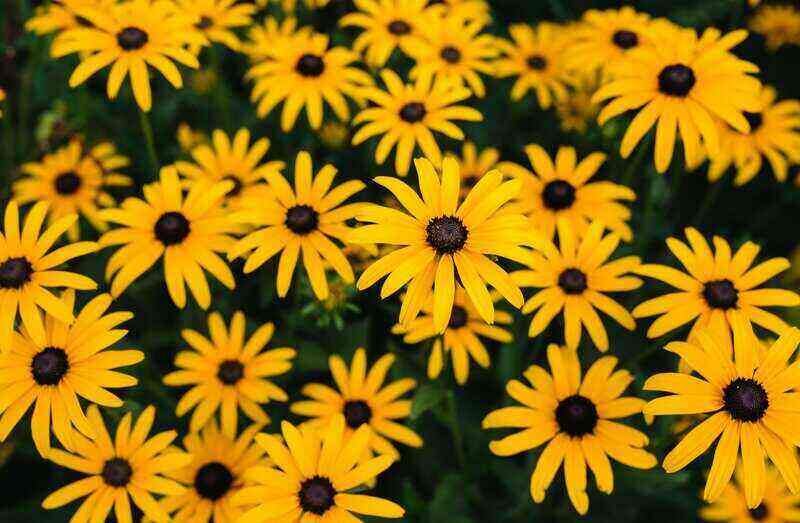
Black-eyed Susan gets its name from the distinctive black or dark brown cone in the center of the flower head, surrounded by bright yellow petals that resemble rays of sunshine. The leaves of the black-eyed Susan are long and lanceolate with a rough texture. Black-eyed Susan is a wildflower that can grow 1-3 feet high.
- Plant type: Flower
- USDA Hardiness Zone: 3 to 9
- Sun: Full sun, but can tolerate partial shade
- Soil: Clay, sand, loam, acidic, moist, well-drained
- Foliage: Perennial
- Bloom time: Spring, summer, early autumn. Flowers in June through October.
- Water needs: Medium. It has moderate drought tolerance
- Mature height: 1 to 3 feet.
- Potential hazards: Not toxic to humans or pets. Toxic to livestock.
- Maintenance: Low. Can self-seed freely. Black-eyed Susan can become aggressive if given too perfect an environment and insufficient competition.
Bee Balm (Monarda didyma)
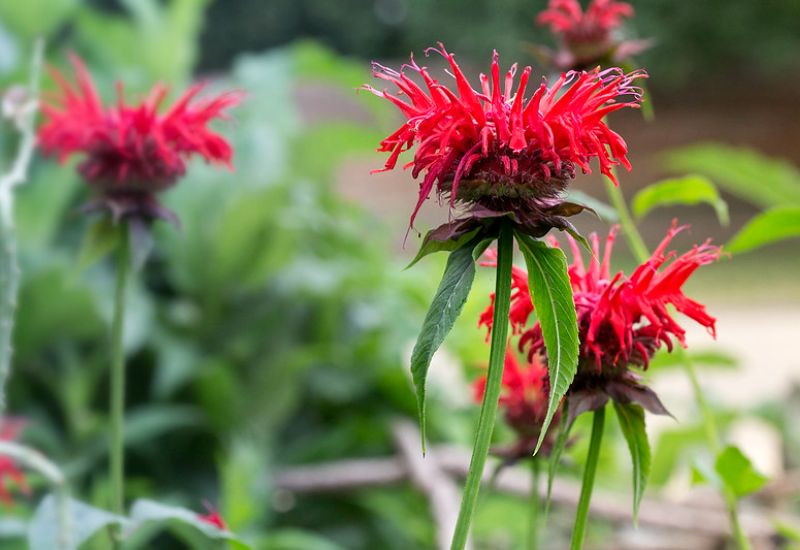
Photo Credit: Watts / Flickr / CC BY 2.0
Bee balm, known as Monarda, is a beautiful native plant found throughout Pennsylvania. It is prized not only for its vibrant scarlet flowers that bloom in the summer but also for its fragrant foliage. The flowers grow in clusters, with slender, tubular blooms in various colors, including white, pink, red, lavender, and purple.
- Plant type: Perennial plant
- USDA Hardiness Zone: 4 to 9
- Sun: Full sun, partial shade
- Soil: Chalk, clay, loam, sand
- Foliage: Perennial
- Bloom time: July to September
- Water needs: Average
- Mature height: 10 to 12 inches
- Potential hazards: Not toxic for humans, but pets can get stomach issues.
- Maintenance: Average
Butterfly Weed (Asclepias tuberosa)
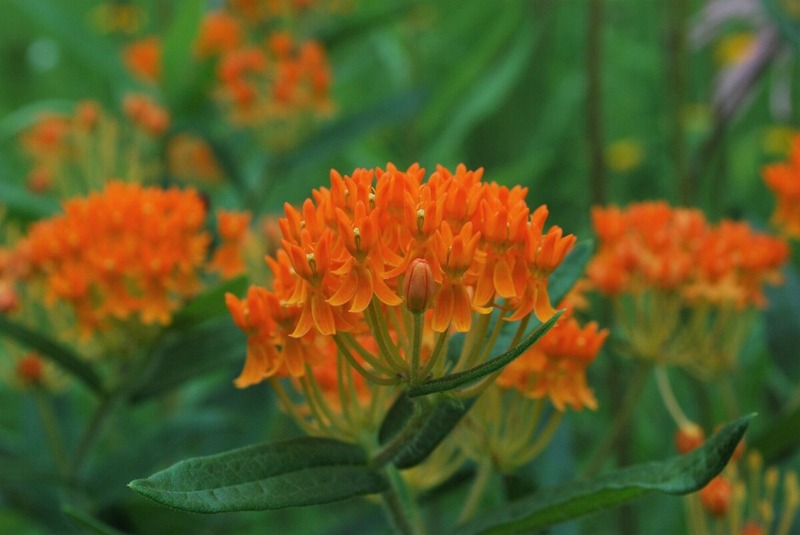
Butterfly weed, or Asclepias tuberosa, is a medium-sized plant that starts off as slender stalks but becomes bushier as it matures. It forms clumps of narrow, pointed leaves and produces stunning clusters of orange or yellow flowers reaching up to 4 inches in diameter.
These plants are commonly found in the southern and urban areas of Pennsylvania, growing to be 1 to 2 feet tall. Butterfly weed, a perennial plant, has a slow growth rate and may take up to 4 years to reach its full size. It can reproduce through either seeds or root division.
- Plant Type: Wildflower
- USDA Hardiness Zone: 3-9
- Sun: Full sun
- Soil: Clay, loam, sandy; well-drained
- Foliage: Perennial
- Bloom Time: Late June through August
- Water Needs: Low
- Mature height: 1 to 2 feet
- Potential hazards: Mildly toxic to humans and animals but less so than its relative the milkweed plant
- Maintenance: Low
Great Blue Lobelia (Lobelia siphilitica)
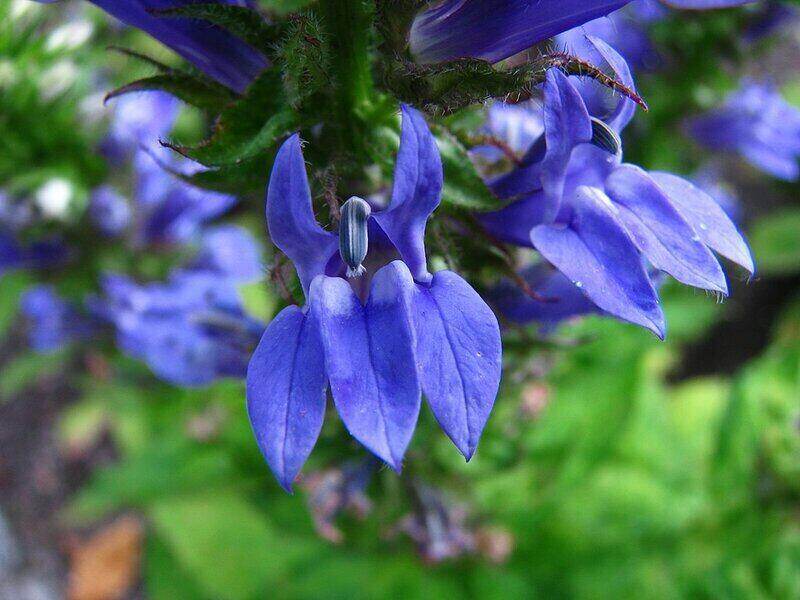
Great blue lobelia, also known as blue cardinal flower, is a perfect addition to any garden with a wet area. This Pennsylvania native plant is beautiful and a great option for a pollinator garden: Its blue blooms attract hummingbirds, butterflies, bumblebees, and other important pollinators.
It can thrive in sunny and partially shaded areas, growing up to 2-3 feet tall. Great blue lobelia is a great choice for late spring blooms and a healthy ecosystem.
- Plant type: Flower
- USDA Hardiness zones: 4a – 9b
- Sun: Full sun, partial shade
- Soil: Sandy, loamy, clay
- Foliage: Perennial
- Bloom time: Late summer to early fall, from August to September
- Water needs: Medium to high
- Mature height: 2 – 3 feet high
- Potential hazards: Is considered to be toxic to humans and pets
- Maintenance: In the spring, prune the previous year’s flower stalks. To prevent self-seeding, it’s best to wait a couple of weeks after flowering before removing the stalks.
Cardinal Flower (Lobelia cardinalis)
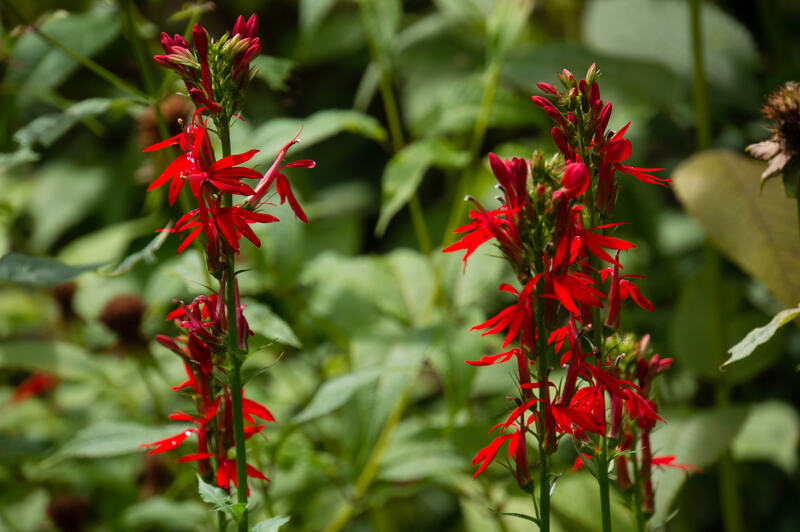
The cardinal flower is a native wildflower of North America with bright scarlet-colored blossoms, making it easy to spot from great distances. This stunning herbaceous perennial grows in wet environments like low woods and stream banks. Very few other native plants have such richly colored flowers as this one does!
- Plant type: Flower
- USDA Hardiness zones: 3-9
- Sun: Full sun, partial shade, full shade
- Soil: Sand, loam, clay, limestone-based
- Foliage: Perennial
- Bloom time: July to September
- Water needs: Medium, High
- Mature height: 1-6 feet
- Potential hazards: Poisonous if eaten in large quantities
- Maintenance: Dividing your plants every two to three years will help prolong life and create more plants.
Perennial Phlox (Phlox paniculata)
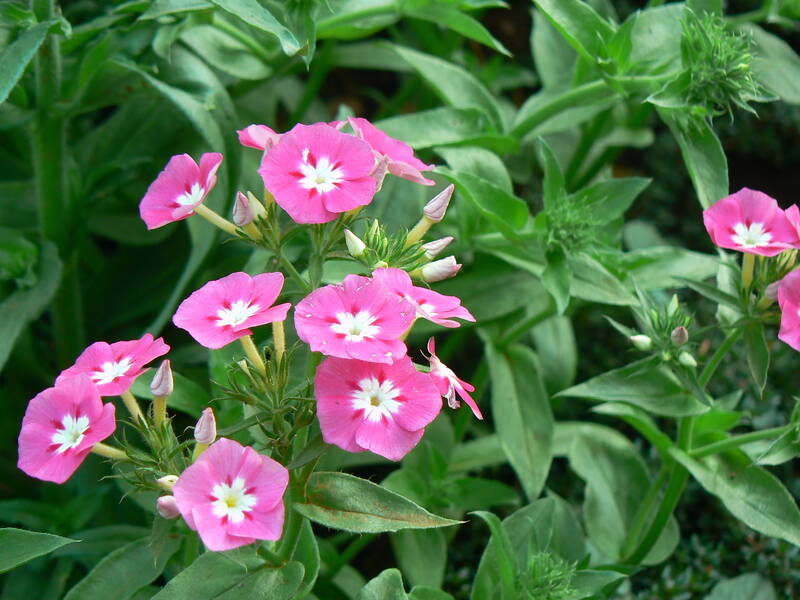
Phlox is a stunning plant that grows in clumps and can reach heights of 3-6 feet. It comes in pink, lavender, and occasionally white and is arranged in a pyramidal cluster at the top of the stem, which can be 4-8 inches wide. The stem is strong and smooth, and the plant’s narrow leaves can grow up to 4-7 inches long.
- Plant type: Flower
- USDA Hardiness zones: 4 – 8
- Sun: Full sun to partial shade
- Soil: Moist, organic, loam
- Foliage: Perennial
- Bloom time: June to August
- Water needs: For newly planted phlox, water once a week for a few weeks. Water as needed during dry periods or when the top couple of inches of soil is dry.
- Mature height: 3 – 4 feet high
- Potential hazards: None
- Maintenance: Divide phlox every 2 to 3 years to ensure a disease-free and healthy plant.
Showy Goldenrod (Solidago speciosa)
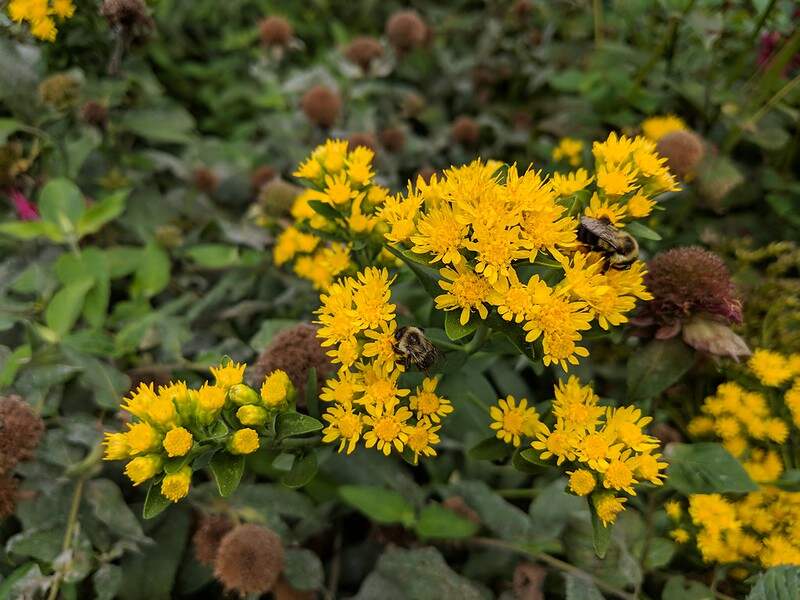
The showy goldenrod is a beautiful perennial plant with an upright habit. It produces stunning clusters of star-shaped lemon-yellow flowers that bloom from mid-summer to early fall. The plant’s narrow leaves stay green all season long, and its brick-red stems add extra beauty to its appearance.
Note: Goldenrod gets a bad rap! Pennsylvanians often blame goldenrod for their seasonal allergies when it’s actually ragweed that causes runny noses, sneezing, and stuffiness in the spring and fall.
- Plant type: Flower
- Hardiness zones: 3a to 8b
- Sun: Full sun, partial shade
- Soil: Rocky, clay
- Foliage: Perennial
- Bloom time: From late summer through early fall, July to September
- Water needs: Low to medium
- Mature height: 1- 5 feet high
- Potential hazards: Medium flammability
- Maintenance: Low to medium; may have to be divided every two years for size management
Swamp Milkweed (Asclepias incarnata)
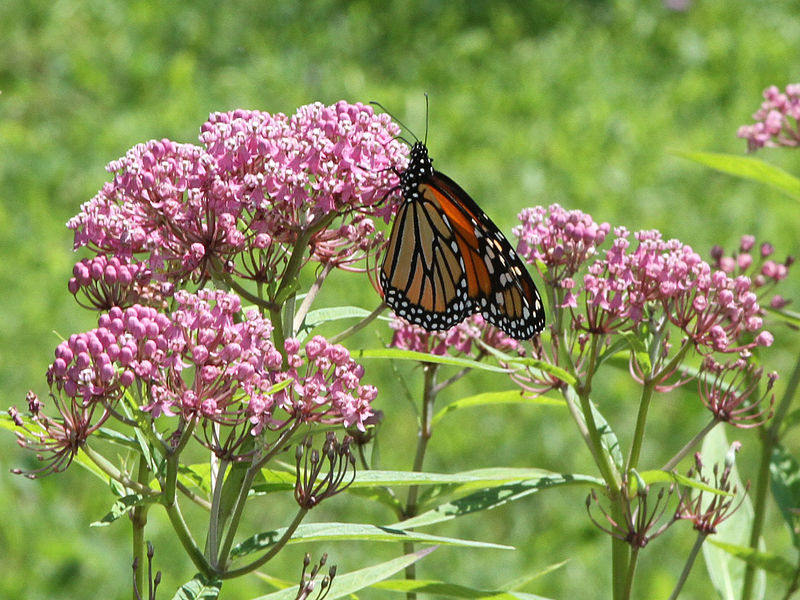
Milkweed thrives in wet soil and can grow in full sun and partial shade. Swamp milkweed has lance-shaped leaves that are smooth and narrow, measuring between 3 to 6 inches in length. During the summer, beautiful flowers, from mauve-pink to purple, emerge. Although the name might suggest otherwise, this flower is not a common lawn weed in Pennsylvania.
Note: The monarch butterfly relies solely on milkweed as its host plant. Female monarchs lay their eggs exclusively on milkweed, and once hatched, the caterpillars feed on the plant’s foliage. Without milkweed, the survival of the monarch butterfly population would be at risk.
- Plant type: Flower
- USDA Hardiness Zone: 3 – 9
- Sun: Full sun to partial shade
- Soil: Wet soil, slightly acid to neutral (6.0 to 7.0)
- Foliage: Perennial
- Bloom time: Summer
- Water needs: Keep the soil consistently damp. If planted in a wetland area, it won’t require additional watering during the growing season.
- Mature height: 1–2 feet tall, 12 to 18 inches wide
- Potential hazards: Mild toxicity to humans and animals
- Maintenance: It will thrive in moist soils or ponds. They should be placed two to three feet apart from each other. Aphids are a normal occurrence on swamp milkweeds, but if the plant looks sick, you can spray the aphids with soapy water.
Virginia Bluebells (Mertensia virginica)
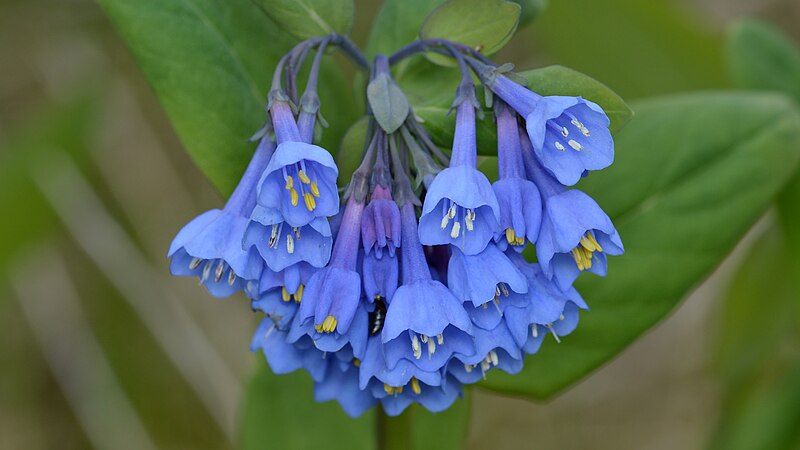
The Virginia bluebell briefly graces us with its presence in the springtime. Its delicate pink buds unfurl into trumpet-shaped blooms of a mesmerizing blue hue, emitting a sweet fragrance that beckons the season’s first buzzing bees, butterflies, and hummingbirds.
- Plant type: Herbaceous
- USDA Hardiness Zone: 3 to 8
- Sun: Part shade to full shade
- Soil: Chalk, clay, loam, sand; acid, alkaline, neutral; moist but well-drained
- Foliage: Perennial
- Bloom time: March to June
- Water needs: Average. It does its best when moisture is abundant and will decline when the soil is too dry.
- Mature height: 1 to 2 feet
- Potential hazards: All parts of the bluebell plant contain toxic glycosides poisonous to humans, dogs, horses, and cattle.
- Maintenance: Medium. This plant self-seeds but is challenging to propagate. It should be cut back after flowering.
Columbine (Aquilegia canadensis)
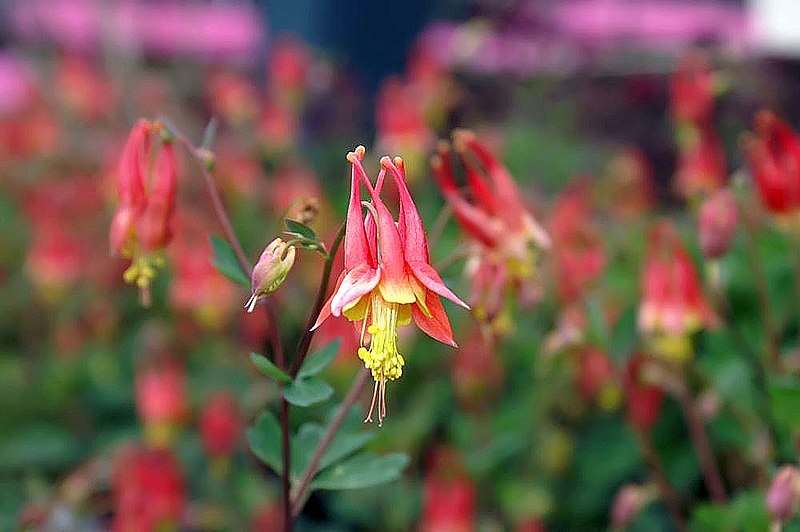
Columbine is a beautiful herbaceous perennial with tall stems adorned with graceful, drooping flowers in shades of red and yellow. The foliage of columbine is delicate and has compound leaves, adding to its overall charm and appeal.
- Plant type: Flower
- USDA Hardiness Zone: 3 to 9
- Sun: Prefers partial shade but will tolerate full sun
- Soil: Moist yet well-drained
- Foliage: Perennial
- Bloom Time: May to June
- Water Needs: Moderate
- Mature height: 2 to 3 feet
- Potential hazards: Slightly poisonous. Do not consume.
- Maintenance: Low
Blazing Star (Liatris spicata)
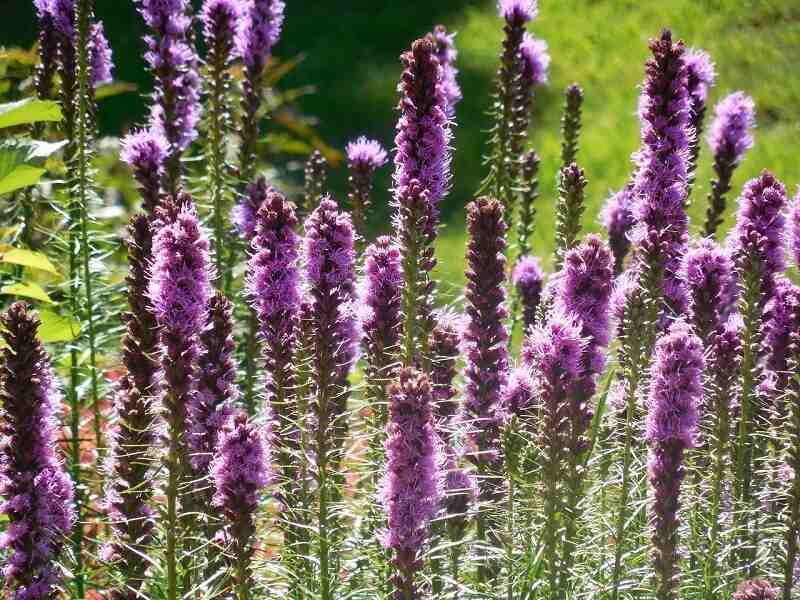
Blazing star is a unique plant with flower heads that are unlike any other. The small, star-shaped blossoms are arranged in a long, upright spire that resembles a bottle brush. The original species has striking purple flower spikes, but pink and white varieties are also available.
The leaves are thin and grass-like, growing in a clump at the base of the plant. They turn a beautiful bronze color in the fall, adding to the plant’s overall appeal.
- Plant type: Flower
- USDA Hardiness zone: 3 to 9
- Sun: Full sun or partial shade
- Soil: Moist clay, silt, or sandy soil that’s well-drained
- Foliage: Perennial
- Bloom time: Summer, from July to September
- Water needs: Low, does not need additional watering once established
- Mature height: 1 to 5 feet, depending on species
- Potential hazards: N/A
- Maintenance: Low once established
Pennsylvania Native Ornamental Grass
Big Bluestem (Andropogon gerardii)
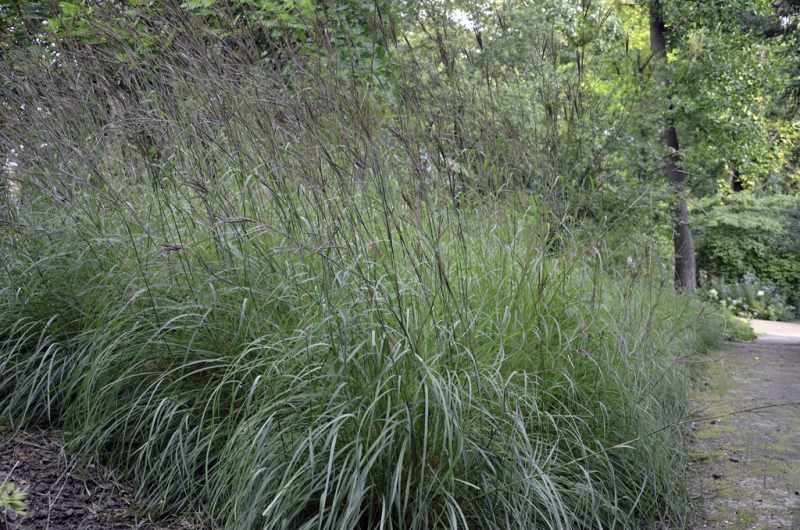
One of the best grasses for Pennsylvania couldn’t be other than the native ornamental grass big bluestem. Its delicate blades sway gracefully in the wind, making it a perfect addition to the landscape or as a border plant along fences. It also works well as a filler plant among other flowers, creating a balanced and harmonious look.
- Plant type: Grass
- USDA Hardiness Zone: 6-7
- Sun: Full sun, poor shade tolerance
- Soil: Moist, acid, or calcareous sands, loams, and clays
- Foliage: Perennial
- Bloom time: August to November
- Water needs: Low, medium
- Mature height: 5-7 feet high
- Potential hazards: None
- Maintenance: It may be cut back or mowed in late winter. It should not be mowed during the growing season, as that could kill it.
FAQ
What are Native Plants?
According to the Pennsylvania Department of Conservation and Natural Resources, native plants are those that occurred in the area before the arrival of European settlers.
What is Pennsylvania’s State Flower?
The mountain laurel, also known as Kalmia latifolia, is the state flower of Pennsylvania. This evergreen shrub is native to the eastern United States and has been admired for its fragrant, star-shaped flowers since colonial times. During the spring season, the mountainsides of Pennsylvania are adorned with the beautiful pink blooms of the mountain laurel.
How Many Native Plants Are There in Pennsylvania?
Pennsylvania has approximately 2,100 native plants. Pennsylvania’s native plants include:
- Vines
- Ferns
- Clubmosses
- Grasses
- Sedges
- Rushes
- Wildflowers
- Shrubs
- Woody Trees
What are the Benefits of Using Native Plants?
There are numerous benefits to using native plant species over non-native species:
- They have adapted to the local conditions, soil, and climate. They can also be more drought-tolerant.
- Native plants provide food for birds: seeds, insects, and caterpillars.
- They attract pollinators, including bees, butterflies, and hummingbirds. These pollinators are crucial in maintaining healthy ecosystems and supporting local agriculture.
- Since they have adapted to local conditions, they typically require less maintenance, such as water and soil amendments. Once the plants are established, they will require little else.
- By using native plants, you can contribute to maintaining native diversity.
Call In The Pros
Looking for a Pennsylvania landscaping pro near you? We have trusted landscaping pros in Philadelphia, Pittsburgh, Allentown, Erie, and many more cities across the “Keystone State.”
Main Image Credit: Joshua Mayer / Flickr / CC BY-SA 2.0
